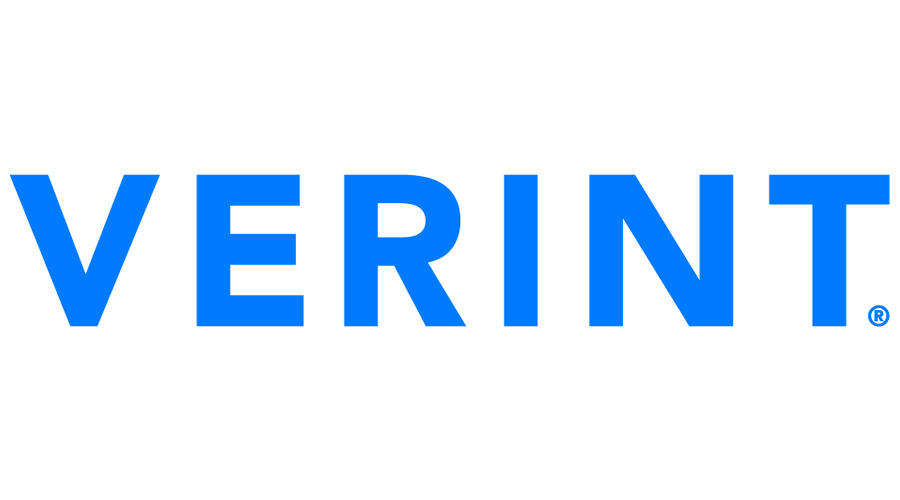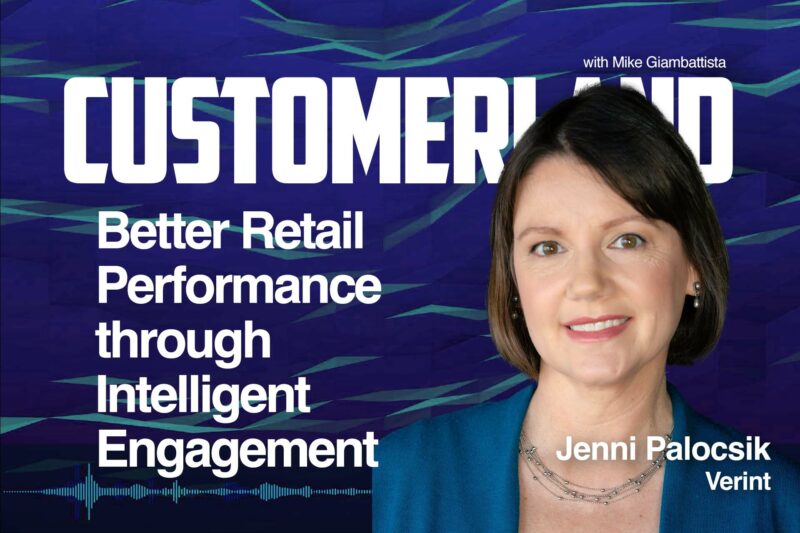Have you ever wondered how customer data can revolutionize your products and services? This episode brings you Jenni Palocsik, the VP of Marketing Insights, Experience, and Enablement at Verint, who unravels how their customer-centric approach has been a game-changer. Jenny shares her extensive knowledge on the power of data, the significance of Verint’s customer engagement data hub, and how their research reports are shaping the future of marketing.

We dissect the findings of Verint’s CX Holiday Survival Guide – a survey of 400 customer engagement brands, giving you an insider’s view into the retail industry’s current state. Discover how the use of artificial intelligence and self-service capabilities can help retailers maximize resources. We also highlight the criticality of a quality customer experience and the potential fallout of a negative one.
Full Transcript Below
Mike Giambattista
Today I’m honored to be speaking with Jenny Palocsik, who is VP of Marketing Insights, Experience and Enablement at Verint, which is a giant title encompassing an awful lot of stuff. I’d love to hear more about that. But first, Jenni, thanks for joining us this morning.
Jenni Palocsik
Happy to be here, looking forward to the conversation.
Mike Giambattista
So we’ve actually got a pretty big agenda things to cover here. But the first thing is can you explain the enormity of your title and what your remit is, what you do for Verint?
Jenni Palocsik
Sure, essentially, I have several teams that report into me, so I’m responsible for everything from the customer experience. When we engage our customers and do quarterly as well as transactional feedback surveys, how are we doing and analyze, based on what they’re telling us, where we can make improvements? So that’s one area of what I do. It also includes things like our customer advisory boards, our user groups and so on. In addition to that, we do a lot around research, so primary research, like the research report we’re going to highlight a little bit today.
So we do studies throughout the year across a wide range of topics, but we feel like they are thought leadership topics that are valuable to us internally to inform what we’re doing, but also that we can share with our customers and the market at large. What are we seeing? How are changes in the market potentially impacting what they need to do and think about with their customers? I also am responsible for our customer and partner portal, parent Connect, and I have a large team that works on sales enablement. So different customer facing and revenue generating rules across the organization, making sure they’re ready to have conversations with customers about how we can help them deliver their business outcomes and just really understand what they need and how parent can help.
Mike Giambattista
That’s a lot of stuff. That’s an awful lot of stuff. You’re covering Silly question. It should be more obvious, but I’ll ask it anyway because I’ve interacted somewhat with people on the product side at Verint – some of the smartest people in CX that I know of. So what’s your interaction with those folks? Are you part of that whole operation, or do you inform into it and then they in turn produce products out towards you? Or how does that really work?
Jenni Palocsik
That’s a combination of things. Just like other large corporations, we collaborate across groups. So, as part of previous roles, as well as working relationships I have with different teams and functions, I regularly interact with our product strategy team, our product managers and our engineers in research and development. I also work very, very closely with our go-to-market team as well as our marketing team. So a lot of my day-to-day interactions are collaborative conversations around what are the demands, what are the needs that we’re hearing from our customers or that our field, our salespeople, are sharing back with us from their conversations with customers.
When we take those inputs into these groups that represent different areas across the business and we come up with our strategy and then we execute on the strategy. So sometimes it’s how do we develop the right messaging so that our customers understand what we are doing and how it can help them day-to-day. Other times it’s are there additional services that we can offer? That would be value adds to the software they have. Sometimes it’s looking at the product roadmap, but I would say I’m working with those people about half of the time and it doesn’t really matter which group you’re in. We’re all working towards a common goal. So it’s been one of the things that I’ve really enjoyed about working here at there.
Mike Giambattista
Yeah, and I can echo that from my limited interactions. I have a decent window into how things work there and it’s one of the more genuinely collaborative organizations I’ve come across. It just seems to be part of the culture there, part of the DNA.
Jenni Palocsik
Yeah, and I think what’s particularly interesting is that it’s not just collaboration at one level of the organization, so the executive team is actively involved. They are passionate about where we’re headed from a strategy perspective. They love to meet with customers and to understand what their needs are, to make sure we’re reinforcing that with what we bring to market, and I have very frequent meetings where there are active participants. In those conversations it’s not simply working with one group or another and the executives are off to the side.
Mike Giambattista
You just gave me a beautiful segue, because one of the findings that I think is most intriguing in the most recent bit of research is how little of the information that companies produce about their customer interactions they’re actually using. I mean, I’ve seen the data on those kinds of things before, but here it is in black and white, and yet Verint seems to be one of those companies that seek exception to the rule. You’re actually using that data. I mean, it’s really what you’re all about.
Jenni Palocsik
Yeah, there’s two. Probably well, there’s more than two, but I think I’d highlight two areas where I think it’s particularly important. We have an engagement data hub, which is essentially where all of our customer interactions whether they’re customer experience interactions that they’re having, text messaging, voice calls, digital messages, all the workflow amongst employees and customers All of that data is used for the customer and by the customer, and it can really be used. We usually talk about it as the gym that trains our bots. So, as we work with customers, instead of having some random algorithms on how things should work better, we’re using their own data around customer engagement to train and improve their bots, their automation, their AI and how they work with their customers. That’s one side of it.
The other side of it that I’d highlight is that our customer success organization works with our SaaS customers and, as part of the ongoing relationships they have with them, they’re also monitoring their usage of our applications.
So they can have conversations with their primary contacts at the customer and say I notice you have quality management in place, but today only about 20% is being used. So are you aware? Did you know, that there are these other capabilities that could really be valuable to you? So we have these conversations and that was just a hypothetical one and we’re able to talk with our customers and say we know you have these applications and you’re using them, but how can you use them for the greater value that you can realize from those solutions to improve your efficiency, your productivity, to make your employees more effective in working with customers? So I think those are two ways we use data, one-on-one with customers, to inform what they’re doing and also to help train all of the applications that they’re using from Verint so that it’s even smarter and more optimized for their particular market and their needs.
Mike Giambattista
So I’d like to, if we can, transition a little bit into this most recent bit of research that you’ve produced, packaged in what’s being called the CX Holiday Survival Guide, which I think is a pretty neat title, because the retailers I’m speaking with and the people who are running CX and back office operations are all in kind of mid-term. I’m in mid-panic mode right now. I mean, it’s a seasonal thing – anxiety probably spikes in a couple of weeks and then things start to settle out. But I think the timing of this report’s really neat, because here we are right in the thick of it. Right in the thick of it. Your findings are, I would have to say – just give me a moment to editorialize. On the one hand, some of it’s not that surprising, but what you’ve done, I think, is offer solutions to some of these really almost universal issues, and I wouldn’t mind going through some of that. And if I can, I want to call out just a couple of statistics here. Let’s see, more than half of retailers surveyed said that effectively staffing stores will be the greatest challenge this year, with 86% facing at least one challenge related to hiring, 50% reporting issues finding qualified people to work in their stores and 30% struggle to fill positions in the contact center and back office. That paints a pretty bleak picture.
Yeah, and you know, honestly, those are. Even though I haven’t seen statistics, the numbers put to those notions, quite this way before, I think it’s kind of universal at this point. You know people understand it, but this does put a finer point on it. Here it is in black and white. There’s a real, genuine issue. What’s different about your report, however, is you offer solutions. So I would love to talk through some of that, some of the ways Verint sees these issues, how you frame up the solutions and what retailers and brands and CX providers can start doing about them.
Jenni Palocsik
Yeah, I’d love to talk about that. I think in the we’ve done several different research studies. This customer experience holiday survival guide is a report that we love doing year over year and it’s one that’s always highly anticipated by our customers and former readers. So we enjoy looking at what the current state is as well as, you know, looking back, you know, are there changing trends that are notable from last year’s holiday season, for example? This is also a research report where we surveyed 400 customer engagement brands on the business side. So sometimes we do consumer research.
This was really talking to the people who are at those companies, engaging with customers, asking them what are their challenges, you know what, what’s really keeping them up at night? And even though I think we’ve seen the retail industry struggle for the past few years, generally, as they head into this active holiday season, it’s even more important that they figure out how can they do more with what they have, how can they do more with less, and a lot of it is around the people side of things. So it’s, you know you might think, oh sure, I’m going to hire a bunch of seasonal workers to add to, you know, my current staff. So as we head into the retail shopping season towards the end of the year, we’ll have more people to interact with our customers. It’s not easy to do that anymore. There’s a lot fewer employees that are just sitting there ready and waiting to join the seasonal staff. But even out of those pools of potential employees, you still have to do all the interviewing and the recruiting and make sure that they’re all trained up and ready to go.
Mike Giambattista
And you have to pay for those people.
Jenni Palocsik
Yeah, you do, you absolutely do, and you know there’s different expectations from the employees as well as from the customers that they’re interacting with. So the bar is raised year over year over year, and we also keep seeing in some of our research that 70% of customers they have one bad experience with a brand. They won’t go back to that brand again. So it’s every single interaction with a customer that is so important. A lot of our conversations with retailers are around how can they Maximize what they are doing Beyond the hiring. So oftentimes we look at things like artificial intelligence, which is, you know, it’s the hot topic Everybody’s talking about, but we don’t want to talk about it in the abstract. We want to talk about it from a technology perspective. And are there ways and Unfortunately, yes, the good news is there are that we can help augment the staff to make it easier for the staff you have to interact with your customers, to make your employees smarter, to Take, you know, kind of offload those tedious tasks that they have to do and free up their time to do what they do best humans interacting with other customers. So I think self-service is always an area that Organizations, that brands, want to make available to their customers, and that’s still Really important because it’s a way to save costs. But you have to do it effectively. You have to know what types of Information your customers are seeking from you, online or through an IVR, so through a telephone, phone tree and automated message. There are still people who like to use the phone In addition to digital and in-person retail interactions. So how does that ecosystem all work together and when do you use technology To make that experience so much better for your customers or for your employees, which also benefits your customers? So it all just really reinforces each other.
But you don’t want to Set up an experience for a customer that they’re in this never-ending cycle of oh shoot, I’m having another conversation and I know it’s not a smart bot and I just really want to get to a human. So, having it monitor and know when you need to transition you know, transfer from a self-service chat bot to an actual live human and how do you automate the process of what are the things that that person was trying to do on their own that they couldn’t do, so they don’t have to repeat themselves. You know all of those things are so important to the experience. I think we’ve all experienced them.
You know, we don’t want to have to Authenticate who we are and then get transferred to another department, have to do it again or explain the story of the problem and then have to do it again. So there’s a lot of things that we can do from an automation perspective that uses AI. It uses that interaction that a customer is having, the brand, and can effectively transfer it to the human agent so they can pick up where the bot left off and have a really satisfying experience with the customer. So I think it’s that marriage between human and technology and how do we balance the two?
WHAT IS AN “EXPECTATION AUDIT”?
What could you achieve if you knew what your customers expected ahead of time? What if you could know what customers expect by category and by brand 12 to 18 months ahead of traditional brand tracking methods? And what if you could know exactly where to adjust and where to spend in order to derive the most benefit every time. A customer expectation audit allows you to identify areas that require strategic reinforcement, as well as pinpoint which values will contribute most to an emotional bond with your brand and optimize accordingly.
Customerland has partnered with Brand Keys, the world’s oldest loyalty focused consumer research firm, to bring real world customer expectation audits to brands, brand managers and to CX practitioners everywhere Want to know where your brand stands and exactly what to do about it.
Go to expectationaudit.com and download a sample audit today.
Mike Giambattista
I’d love to talk a little bit more about some of the specific solutions that Verint has developed to solve those kinds of use cases, because there are any number of. There’s a huge variety of problems a customer might have. There are personality differences and cultural differences and levels of urgency and every variable you can think of probably packed into how a brand or retailer or somebody who’s dealing with customer experience at scale has to respond to these kinds of myriad situations. So how does Verint address that? Maybe we can talk about some of the specific solutions you’ve developed.
Jenni Palocsik
Sure. So you know, we are very much a SaaS company, so we offer our applications on our platform and it’s a customer experience automation platform. So you can use one application or you can use more applications from Verint, and the more you use, the more they can work together, similar to how other enterprise SaaS companies work. We have really been focusing on how artificial intelligence and the customer engagement data we already know from our decades of work with other brands how it all comes together. So we have, you know, we started talking about bots as kind of that expression of not just this nebulous AI in the abstract. But are there individual bots that can work single purpose, very purpose driven, focused bots that can help an employee, whether it’s an agent or a back office employee or someone else in your organization? How can they help them do their job better?
I think there’s a lot of fear around our bots going to replace people. We don’t take that mindset, you know. We really think it’s the way that organizations are going to be able to scale with the employees that they have and to really perfect how they interact with each other. So we have lots of bots and, depending on a brand’s business challenges, it’s not a one size fits all. You know you can start anywhere. We always like to have conversations with customers around what are your particular business challenges? So are you having a lot of trouble with kind of that wrap up scenario that I was mentioning? If you have people calling into your contact center on the phone, are you having your agents? Are they spending a lot of time typing up notes after the call? And because they’re typing up those notes, because it’s important for the next time the customer calls in, while they’re typing up those notes, it’s not a funding for an agent have to do and it takes up time and that time is money when they could be talking to the next customer.
Mike Giambattista
It’s also subject to human error and what you’re going to remember from the conversation, etc.
Jenni Palocsik
Yeah, and from a consistency perspective, you know, one agent might do it very differently from the next. So there is a way to apply AI so that we are capturing that call summary and we are doing that wrap up and capturing the notes that can be put in your CRM system. So that’s one of the bots we have. We also have bots that can evaluate the quality of the conversation on the phone or the digital interaction that an employee is having with a customer. So our quality bots are automatically scoring. They can score the interactions, whether they’re phone calls, and we do transcribe those phone calls for our customers.
We’re able to smartly assess what happened during that call. Did they greet the customer? Were they providing accurate information? Were they providing disclosures? Did we protect their information as part of that transaction? All of the things that happen between customers and the employees at a brand. It’s being recorded these days. But what are we doing with that data? How do we protect the brands? So how do we identify regulatory risks? But how do we also make the employees smarter? You know, oh, we really need to coach you on this point and it’ll make your calls quicker. Better resolution customers don’t have to call back. So there’s this reinforcement, this continuous improvement. That goes on. So some of our bots help with that too. So all the different use cases.
I think we’ve got more than 30 different bots now. We’re heading towards 50 before the end of the year. It sounds like a lot, but we don’t have conversations with a customer and say here’s our menu of bots, which one do you want? It’s much smarter than that. We want to understand what an organization’s business challenge is and then, as we have that conversation, we know where their problems are and we can suggest ways that they can tackle it. And, depending on their priorities, they get to have that collaborative conversation around how we can help them and where their priorities are. What do they want to do first, and then we continue that journey over time.
Mike Giambattista
One of the most intriguing aspects of what I understand again, this is a sidelines perspective, but what I understand of Verint’s approach here is that you’ve been building your large language model at the core of all this AI for whatever.
It’s been a decade or more, which now is an enormous database of the way people approach their problems, their issues. But I think more importantly, it’s the way they feel about the way they approach those things and the way they feel about the outcomes of them. And, speaking with a couple of your colleagues a while back, your Verint’s ability to produce which is the wrong word, but you’ll get what I’m saying empathy at scale in kind of an automated fashion, which already sounds disingenuous, but it’s not. It’s all about caring for your customer at scale. It’s pretty remarkable. So, as I understood it, Verint’s large language model is so large that it can detect and has a reference point, or many of them to detect inflections, tones, full sentiment analysis, when somebody’s there, to try and meet that person where they are or where you can anticipate they really want to be met.
Jenni Palocsik
Yeah, it’s really powerful, and the large language models also all of our historical data and we aggregate it. We’re not sharing personal data from one customer to the next, but we’re using it to get smarter about those interactions. What are the anticipated outcomes? Our applications absolutely leverage all that data that we’ve been building up over time. So you talked about empathy. We have an intelligent interviewing module that contact centers can use when they are in need of hiring more contact center agents and instead of just talking to them on the phone a recruiter we can essentially assess their empathy score. How are they able to not just do the skills that are important around the phone and typing and looking up information or being pushed information but what is their maturity around being able to read what’s happening on the phone, and that, combined with the automated alerts, as behind the scenes, we’re detecting automatically that a customer is frustrated, or the agent if they’re pausing too long.
So whole times or silence on the line can be really tense and, from a customer perspective, you’re waiting for the next answer to come back from the agent. So all of our intelligence around that can do things like prompt the agent. What happened? Did you put them on hold? Did you put them on hold too long. So some of it is coaching for the next interaction. But more importantly is how can we prompt real time during that interaction to recover, to remind the agent how important it is to take the customer off hold quickly or let them know before you have to put them on hold, instead of an abrupt interaction while they’re trying to get their problem solved? There’s so much around the intelligence, around assessing what is being said on the call, the words that are used, the emotion, the tone and the voice, and it all comes together really powerful.
Mike Giambattista
We’re talking about a really sophisticated set of solutions to a really wide variety of CX issues that arise. One of the things that I think we should point out here is that your research also uncovered that companies that deploy these kinds of solutions based on listening to their customers, based on assessing and understanding the data they’ve collected, have a genuine return on investment impact on the whole effort, and the numbers behind that are pretty stunning to me. I mean we alluded to this earlier in a conversation that there only a small percentage of companies that really fully utilize the data they have access to on their customers, but the ones that do are really outperforming the ones that don’t. Significantly and I’m going to pull this right from your report as well Retailers that connect the customer data across all engagement channels are more than three times I’m just going to say 3x and let that hang in the air for a moment, because it’s big as likely to use insights very effectively to improve their experiences in digital channels. In fact, the study found that those retailers are very effectively leveraging insights to improve experiences in stores 73% in store and 75% digitally. 3x is a giant number. I don’t care what realm you’re looking at. 3x in anything is something worth paying attention to.
So I want to point out for everyone who’s listening to this that the Verint CX Holiday Survival Guide will have a link to it underneath the podcast, and you can find the podcast wherever you listen to podcasts all over the podcast universe. But there’s loads here that I think prove the points that we all kind of understand, but further goes to providing solutions that are implementable. It’s not just pie-in-the-sky theory. These are things that won’t go so far to say they’re plug-and-play, but there’s things that you can implement as a retailer quickly in time for impact on your customer experience this holiday season. So, and I would encourage you to download it. As I said, links will be all over the place and I want to thank Jenny Palocsik, for your time and your insights, and I’m so looking forward to continuing these conversations.













